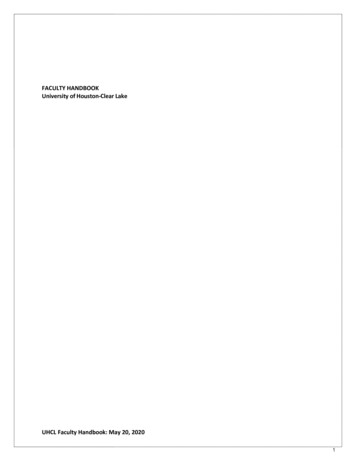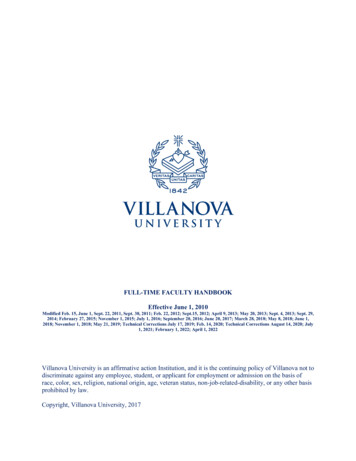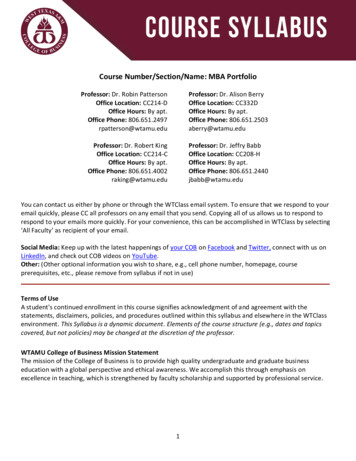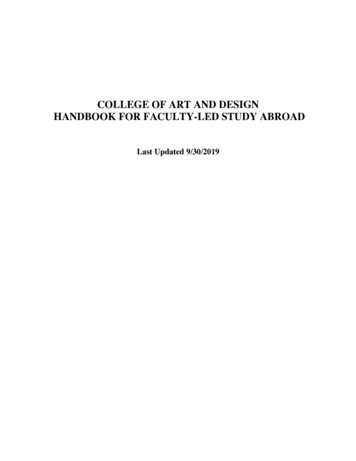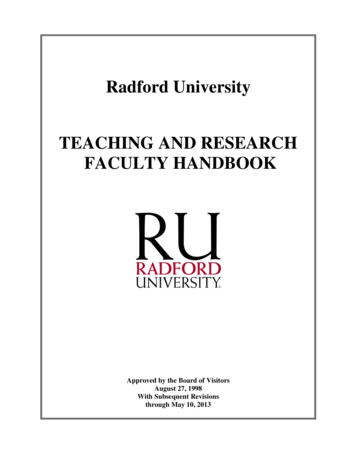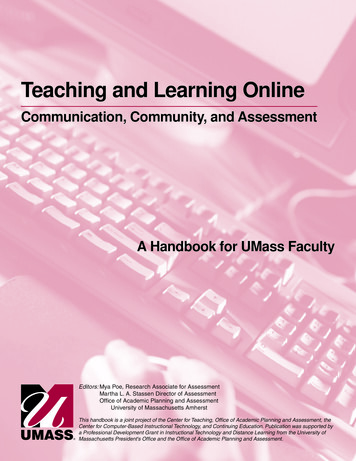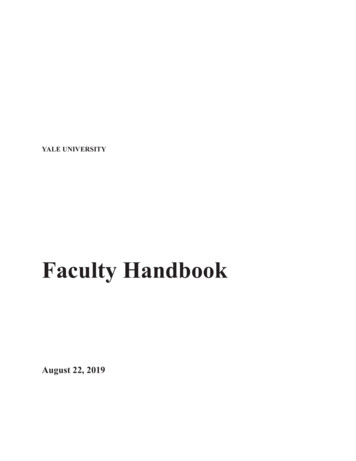
Transcription
YALE UNIVERSITYFaculty HandbookAugust 22, 2019
CONTENTSIntroduction .1University Organization .2A. History.2B. The Yale Corporation .2C. Officers of the University .3D. Schools and Faculties of the University.3II.Academic Freedom and Faculty Standards of Conduct .5III.Faculty Ranks, Appointments, and Policies: University-wide.8A. Equal Opportunity and Affirmative Action .8B. Faculty Ranks.8C. Recruitment and Approval Process for Faculty Appointments .9D. Authority to Appoint .9E. Appointments and Terms of Employment .10F. Maximum Time in Non-tenure Ladder Ranks .10G. Notice of Termination and Non-reappointment .12H. Fully Joint and Secondary Faculty Appointments .13I. Part-time Appointment to the Ladder Ranks of Assistant Professor, AssociateProfessor, and Professor .14J. Dual Appointments as Faculty and Managerial or Professional Employee.15K. Faculty Appointment Procedures .16L. Decisions Not to Reappoint or Promote and their Review .19
M. Review Procedure for Complaints about Issues Other than Reappointment orPromotion.23N. Review Procedures for Complaints about Violations of the Faculty Standardsof Conduct.23IV.Faculty of Arts and Sciences .29A. Description.29B. Governance .29C. Academic Departments and Programs .32D. Assignment to the Graduate School Faculty .34E. Appointments Procedures .35F. Voting Policies.35G. Meetings of the Faculty . .38H. Ladder Faculty Ranks .40I. Other Instructional Appointments .48J. Instructional Opportunities for Yale Graduate and Professional School Students.53K. Research Appointments .54L. Leaves of Absence .54V.School of Architecture .58A. Description .58B. Governance: The Executive Committee .58C. Composition and Ranks of Faculty .58D. Appointment, Reappointment, and Promotion Policy and Procedures.61E. Leave Policy and Procedures .63F. Research/Travel Funds.63
VI.School of Art .64A. Description .64B. The Governing Board and the Appointments Committee.64C. Composition and Ranks of Faculty .64D. Appointments .65E. Leave Policy.66VII.Divinity School and Institute of Sacred Music .67A. Description .67B. Governance .67C. Faculty Ranks.68D. Appointments .68E. Termination Policy .71F. Leave Policy.71VIII. School of Drama .72A. Description .72B. Faculty Composition and Responsibilities.72C. Faculty Ranks.73D. Appointments .73E. Reappointments and Promotions .74F. Leave Policy.74IX.School of Forestry & Environmental Studies .75A. Description .75
B. Governance .75C. Ladder Faculty Ranks and Appointments .76D. Leave Policy.76E. Other Instructional and Research Appointments .76F. Instructional Opportunities for Graduate Students (Ph.D., D.F.E.S. and Masters).79X.Law School .80A. Description .80B. Appointments: The Governing Board .80C. Faculty Ranks.80D. Leave Policy.82XI.School of Management .83A. Description .83B. Governance .83C. Ladder Faculty .83D. Non-Ladder Faculty .85E. Other Appointments .87F. Procedures for Appointment .88G.Leave Policy.88XII.School of Medicine .90A. Description .90B. Departments .90C. Governance .91
D. Supervision of Students .92E. Appointments and Promotions Procedures .92F. Faculty Tracks .94G. Professor in the Practice and Adjunct Faculty Ranks.103H. Other Clinical Ranks .103I. Voluntary Ranks .104J. Research Ranks .104K. Other Instructional Ranks .105L. Training Ranks .105M.Coterminous Appointments .106N. Leave Policy.107O. Joint Appointments .107XIII. School of Music and Institute of Sacred Music .108A. Description .108B. Governing Committees .108C. Faculty Ranks and Appointments .109D. Joint Appointments with the Department of Music .110E. Off-campus Professional Engagements .110F. Leave Policy.110G. Termination Policy .110XIV. School of Nursing .111A. Description .111
B. Governance .111C. Faculty Composition and Responsibilities.112D. Faculty Ranks.113E. Terms of Appointment .116F. Procedures for Appointments and Promotions .117G. Coterminous Appointments .117H. Courtesy Faculty .117I. Leave Policy.118XV.Research Appointments: University-wide .119A. General Policy .119B. Description of Research Faculty Ranks .119C. Postdoctoral and Other Non-faculty Research Ranks .122XVI. Visiting Appointments: University-wide .126A. Visiting Teaching Faculty .126B. Visiting Research Faculty .126C. Visiting Fellow .126XVII. Leaves of Absence and Teaching Relief: University-wide .127A. General Conditions Governing All Leaves .127B. Leaves with Salary from University Funds . 129C. Leaves without Salary from University Funds .132D. Child-Rearing Leaves, Caregivers Leaves, and Parental Leave Policies .134XVIII.Faculty Compensation, Benefits, and Services .138
A. Salaries .138B. Summer Compensation from University-administered Funds .140C. Other Compensation from University-administered Funds .141D. Fringe Benefits .142E. Services for International Faculty and Research Staff.149F. The Office of International Affairs .152G. Resources and Accommodations for Faculty Who Have Disabilities .153H. Business and Administrative Support .153I. Yale Travel Services.154J. Parking .154K. Identification Cards .154L. Identification Cards for Spouses and Partners .154M.Letters of Introduction .154N. Yale NetIDs .155O. Technology and Computing Support for Faculty.155XIX. Retirement .156A. Full Retirement and Emeritus Rank.156B. Phased Retirement Plan .159XX.University Policies Concerning Teaching and Research .160A. Instructional and Institutional Responsibilities.160B. Safety Issues.161C. Research and Scholarship .162
D. Patents, Copyrights, and Licenses .167E. Outside Interests and Employment .168F. University Equipment .174XXI. Other University Policies Affecting Faculty .175A. Sexual Harassment .175B. Teacher-Student Consensual Relations .176C. Accommodations for Students with Disabilities.177D. Employment of Members of the Same Family and Related Matters.177E. Short-term and Long-term Medical Disability .178F. Standards of Business Conduct.178G. Appropriate Use of Technology Resources .179H. Military Service .179I. Jury Duty.180J. Use of University Facilities .181K. Use of University E-mail Addresses, Websites, and Stationery .181L. University Federal Relations.182M.Faculty Involvement in Community Activities .182N. University Tribunal .182O. Indemnification for Legal Expenses .182P. Workplace Violence Prevention Policy.182Q. Emeriti Titles.183
I. University Organization1IntroductionThe purpose of the Yale University Faculty Handbook is to present in a convenient form themost important University policies and practices as they apply to the faculties of the University.The policies included and referred to in this Handbook form part of the essential employmentunderstandings between members of the faculty and the University.The Handbook is meant to inform and serve members of the administration as well as thefaculty. It is available on the Office of the Provost website. The text of the Handbook includeslinks to University policies and resources available on Yale websites.The Handbook will be revised as University policies evolve and an updated version of theHandbook will be posted online so that faculty may stay aware of changes in Universitypolicies. A memorandum highlighting significant changes to the Handbook will be distributedto faculty with each new edition.
2Yale University Faculty Handbook — August 22, 2019I. University OrganizationA. HistoryThe institution that became Yale University was founded in 1701 as the Collegiate School byten Congregational ministers in Saybrook, Connecticut. In 1716, the school was moved to NewHaven. The School of Medicine was opened in 1813, and a Department of Theology, predecessorto the Divinity School, was created in 1822. In 1824, a private law school conducted in NewHaven by three Yale graduates became affiliated with Yale College, and the Bachelor of Lawsdegree was conferred by Yale for the first time in 1843. The Sheffield Scientific School and theGraduate School followed. The first Ph.D. awarded in America was conferred at Yale in 1861. In1887, the institution was given the legal title of Yale University. Schools of Music, Forestry &Environmental Studies, Nursing, Engineering, Drama, Art, Architecture, and Management werefounded later. The activities of the Sheffield Scientific School were assumed by Yale College andthe Graduate School in 1945. The School of Engineering, part of the Sheffield Scientific Schoolfrom 1861, was established as a separate school in 1932. In 1962, most of its academic responsibilities were transferred to the Department of Engineering and Applied Science, which has sincebeen divided into several departments, called the Faculty of Engineering and headed by a Deanof Engineering. Women were admitted as regularly enrolled students to the Graduate School in1892 and to Yale College in 1969. Since 2007 the Department of Epidemiology and Public Health,which is formally part of the School of Medicine, has been called the Yale School of Public Health.In 2008 the Faculty of Engineering became recognized as the School of Engineering & AppliedScience, which is formally a part of the Faculty of Arts and Sciences (FAS) for the purposes offaculty appointments and governance. In 2014, Yale added the position of Dean of the Facultyof Arts and Sciences to its administrative structure, with oversight responsibility for the facultyand departments of the FAS.B. The Yale CorporationYale’s Charter provides that the final authority in the “government, care and management” of theUniversity is the Yale Corporation, a body of nineteen Fellows consisting of the President of theUniversity, who presides at all meetings, the Governor and Lieutenant Governor of the state ofConnecticut, ex officiis, ten Fellows who are the “Successors of the Original Trustees” and whomay serve for two successive terms of six years each, and six Alumni Fellows, one elected eachyear by the graduates to serve for six years. Upon recommendation of the President, in specialcircumstances a Successor Trustee may be elected to an additional term of up to three years.Alumni Fellows are eligible for appointment as Successor Trustees. Meetings of the Corporationare held regularly during the academic year.
I. University Organization3C. Officers of the UniversityThe Officers of the University are appointed by the Corporation. They are the President, Provost,Vice President of the University, Vice President for Finance and Business Operations, Vice Presidentfor Development, Vice President and General Counsel, Vice President for New Haven and StateAffairs and Campus Development, Vice President for Human Resources and Administration,Secretary and Vice President for Student Life and such others as the Corporation may designate.A description of the authority vested in each of them and the responsibilities of their respectivepositions is given in The Yale Corporation By-Laws.D. Schools and Faculties of the UniversityYale considers itself to have twelve professional schools within the University. Ten of these schoolshave formal governance and faculty appointment procedures and have the authority to awarddegrees by recommendation of the Dean of the School. The two remaining schools – Public Healthand Engineering & Applied Science – do not have the authority to appoint faculty, as they remaindivisions of the Schools of Medicine and the Faculty of Arts and Sciences, respectively. They do,however, each have a Dean appointed by the President and approved by the Yale Corporation,who oversees development and administrative matters within the school.Degrees and courses of study in the University are offered in the twelve schools listed here withthe date each was founded: Yale College (1701); School of Medicine (1813); Divinity School(1822); Law School (1824); School of Art (1865); Graduate School of Arts and Sciences (1892);School of Music (1894); School of Forestry & Environmental Studies (1900); School of Nursing(1923); School of Drama (1955); School of Architecture (1972); School of Management (1974).Each school has its own Dean, faculty, and board of permanent officers or other governing body,as approved by the Yale Corporation. The faculties of Yale College and the Graduate Schoolconstitute the Faculty of Arts and Sciences, which is under the direction of the Faculty of Artsand Sciences Executive Committee, composed of the President, the Provost, the Dean of theFaculty of Arts and Sciences, the Dean of Yale College, the Dean of the Graduate School, and theDean of the School of Engineering & Applied Science.Subject to the overall authority of the Corporation, on recommendation by the President or Provost,the faculty of each school, acting through such committees and procedures as it may adopt, hasthe power to determine the school’s educational policies. In the Faculty of Arts and Sciences, thefull professors of that faculty meet together for the purpose of acting on appointments, and that
4Yale University Faculty Handbook — August 22, 2019meeting is referred to as the meeting of the Joint Boards of Permanent Officers of Yale Collegeand the Graduate School. In each of the professional schools, the full professors on permanentappointment, as well as, ex officiis, the Dean of the School and the President and Provost,constitute the board of permanent officers except where the appointment structure of a schoolrequires a different governing body, as approved by the Corporation.
II. Academic Freedom and Faculty Standards of Conduct5II. Academic Freedom and Faculty Standards of ConductA. University Policy on Freedom of ExpressionIn 1975, the Committee on Freedom of Expression at Yale,1 chaired by Professor C. VannWoodward, wrote the following:The primary function of a university is to discover and disseminate knowledge bymeans of research and teaching. To fulfill this function a free interchange of ideasis necessary not only within its walls but with the world beyond as well. It followsthat a university must do everything possible to ensure within it the fullest degreeof intellectual freedom. The history of intellectual growth and discovery clearlydemonstrates the need for unfettered freedom, the right to think the unthinkable,discuss the unmentionable, and challenge the unchallengeable. To curtail freeexpression strikes twice at intellectual freedom, for whoever deprives another ofthe right to state unpopular views necessarily also deprives others of the right tolisten to those views.Members of this University have freely associated themselves with Yale and in doing so haveaffirmed their commitment to a philosophy of mutual tolerance and respect. Physical restriction,coercion, or intimidation of any member of the community is contrary to the basic principles ofthe University. It is also a violation of these principles and of the University’s rules of conduct forany member of the faculty, staff, or student body to prevent the orderly conduct of a Universityfunction or activity, such as a lecture, meeting, interview, ceremony, or other public event. It issimilarly a violation of these principles to block the legitimate activity of any person on the Yalecampus or in any Yale building or facilit
Aug 22, 2019 · The Handbook will be revised as University policies evolve and an updated version of the Handbook will be posted online so that faculty may stay aware of changes in University policies. A memorandum highlighting significant changes to the Handbook

